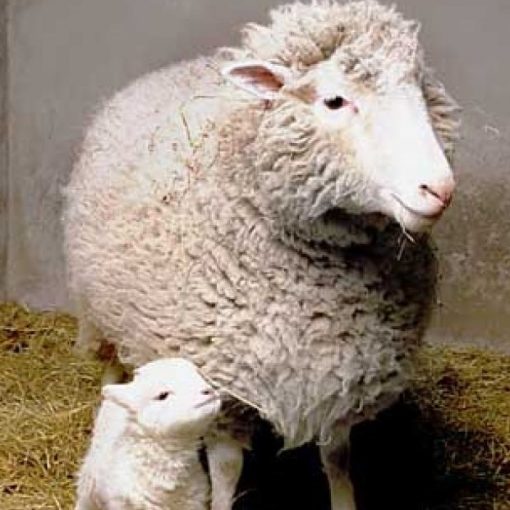
Science has yet to solve major mysteries concerning life’s spontaneous selfassembly into intricate patterns. While explanations may one day be found by focusing entirely on genes and molecules, an elegant alternative already exists. For living beings have the capacity to behave as energy resonators, trapping spatially patterned light (electromagnetic energy) within them. This patterned energy field is called a resonant mode and may guide key aspects of biological development.
The Gene Myth
It’s in the Genes
Each and every day we encounter stunning mysteries in the exquisite patterns created by living beings. Remarkably, these intricate patterns arise spontaneously from a simplistic initial state showing no traces of the patterns to come. This is of course not what we typically see happening in the realm of non-living materials. Imagine shining sunlight and pouring water onto a pile of bricks, glass, and cement, standing back, and watching these elements jump into the construction of a house. This just doesn’t happen! While we may have assumed science has already deduced the mechanisms behind life’s self assembly processes, in reality many core aspects of biological development, including things as ubiquitous as a leaf’s vein patterning and the proportion of digits in a hand and arm, remain open questions. We may take it for granted, but living beings are capable of something truly awe inspiring and seemingly miraculous.
If we ask a conventional scientist to explain how living things spontaneously create an exquisite something out of nothing, we’ll probably be told the answer is to be found in the living being’s genes. How does a watermelon plant know how to make male and female flowers, respond to pollen grains transferred to the female flowers to swell the ovary into a multi-billion celled structure with a striped rind, juicy pink patterned flesh, and seeds that can recreate more watermelon plants out of thin air, water, and trace soil nutrients? It’s in its genes. This reference to genetic information is somehow assumed to adequately explain most structural, and some behavioral, phenomena exhibited by living beings. How does that spider know how to weave its web? It’s in its genes. We even claim to account for things like alcoholism, obesity, and schizophrenia by making reference to that special something in genes. Yet, in these particular examples, does this reference explain much of anything at all?
A gene does nothing more than encode information required to produce a particular protein. If we consider inherited biological mysteries in more depth, there’s actually an incredibly immense gap between the activity of a protein-producing gene and the precise and involved sequence of movements required for a spider to weave a web, or an explanation for how a mathematically describable, intricate pattern involving billions of cells can spontaneously emerge in a developing life form. There’s a similar lack of connection between genetic activity and why an alcoholic feels compelled to reach for that next drink.
The mystery in each of these scenarios is still very acute, but is covered up by the assumption that the explanation is right there ‘in the genes’. In reality, while correlations may exist between genes and traits, there is rarely an explanation to be found in knowledge of the genetic activity alone. In mistaking correlations for explanations a self-consistent mindset, which I’ll call the Gene Myth, has arisen to dominate views and activities in biology and medicine.
Limits of the Gene Myth
I believe that every scientific theory is a functional myth; a story that works really well in some contexts and fails miserably in others. Like most important scientific stories, the Gene Myth really does connect the dots for a number of simple and straightforward cases.
One simple example of where the Gene Myth does work well is in explaining why one variety of plant produces red flowers while the other makes white ones. Here we can make a distinct connection between what’s happening in the flower and this plant’s genes. For example, the color in red flowers might come from a red pigment molecule, while the color in white flowers represents the absence of the pigment. The red pigment might be formed when a specific enzyme (a.k.a. geneencoded protein) acts on an uncolored precursor to the red dye. Maybe this precursor has a lobe of atoms on one side that the enzyme lops off, and when this happens, it interacts with light in a different way to take on a red hue. The uncolored pre-pigment molecule might be present in both red and white flowered plants, but only the plant with red flowers produces the enzyme required to make the necessary modifications. This enzyme in the red-flowered plant is encoded in an information sequence in its genes. The white-flowered plant has no such genetic information sequence, cannot produce the enzyme, and therefore produces only white flowers. Case closed; mystery solved. Red flowers are indeed an inherited trait to be explained by what lays in the plant’s genes and the proteins they call for.
Yet even this simple case of red and white flowers can confound the Gene Myth if we think just a little more about it. For every single cell in the billions of cells that make up the plant contain exactly the same collection of genes (except for gamete cells like pollen and ova, which contain half). It’s not that the flower petals contain the genes specific to producing red petals, while the leaves contain instructions for how to make green leaves. No. Every single cell in the non- reproductive organs of the plant contains exactly the same parcel of genetic information. And genetic information isn’t an instruction set, like a software program; it merely encodes for proteins. So in considering just one plant, why do the flowers turn out red, while the leaves and stems turn out green and the roots white? What about the dramatically different architectures exhibited by all of these different parts? And even more mind-bogglingly, the plant begins as this little ambiguous seed and creates leaves, stems, flowers, roots, fruits, and seed-filled pods out of thin air, water, and soil.
The Gene Myth is nowhere near as simple as it seems, as life’s patterns and behaviors can only be explained when we adopt much more sophisticated stories. In these new stories, the gene isn’t the central player in the game plan of life. It is but one element in a complex game plan involving many elements engaged in different interactions at multiple scales of meaning. Genes, the proteins they produce, the activity of proteins, and the contexts of cells, tissues, whole organisms, and environments embedding all of the above are all necessary to even begin to understand most biological manifestations.
Life and Energy
My view differs from those of many mainstream scientists as I believe genes, molecules, and material substances in general, are quite simply not enough to account for the wide array of mysterious and amazing phenomena observed in living beings, no matter how clever the game plan they’re involved with. In contrast, I believe that entirely non-materialistic, entirely energetic phenomenon, are actually the essential primordial causes required to fully account for life’s more remarkable accomplishments. By making genes and proteins the responsive elements to an overriding energy-based mechanism, we can easily explain a whole range of biological manifestations, and the Gene Myth is inherently challenged to evolve.
Energy-based phenomena such as electromagnetism (light, but not necessarily the visible kind) can give us an elegant and comprehensible account for the spontaneous emergence of intricate patterns from a simple initial cluster of cells. Electromagnetism describes a special manifestation of energy in the form of a wave-field consisting of intertwined electric and magnetic fields, each oscillating in strength in space and time.
Visible light is perhaps the most obvious form of electromagnetic wave-fields in our everyday lives, but microwaves, radio waves and x-rays represent the same phenomenon at different frequencies of oscillation and follow similar physical principals to visible light.
Importantly, an energy-based perspective can be a completely scientific one. Electromagnetic energy is a model that can be explored and detected experimentally. In addition, as we’ll see, an understanding of biological pattern formation in terms of electromagnetism can be entirely consistent with the previously established physics-based understanding of how electromagnetism ought to behave, and the previously established observations and understandings of biological pattern formation in terms of genes and molecules.
And if a living being can indeed produce and make deliberate use of electromagnetic radiation, a vast array of new possibilities becomes available for enhanced understandings of living beings and the phenomenon of life. Would evidence of self-created electromagnetism be evidence of life energy? Would this be the same energy that nearly every single holistic medical system has discussed and worked with for thousands of years?
Life Electromagnetic?
In 1968, physicist Herbert Fröhlich first proposed life to be at least theoretically capable of producing electromagnetic wavefields in a frequency range somewhere between the highmicrowave (1011 Hz) through to the terahertz (1012 Hz) 1, 2.
The basic concepts of Fröhlich’s theory are not so difficult to appreciate. An electromagnetic wave-field is produced when a charged bit of matter vibrates in a periodic way. The frequency of the electromagnetic wave-field corresponds to the frequency of the material’s vibration. the material’s vibration.
Living systems contain numerous molecules and larger structures that carry an electrical charge and are vibrating with heat energy. One of the simplest of these molecules is water, which has an electric charge separation due to an uneven drawing of electrons by oxygen from its two conjoined hydrogen atoms.
Under typical conditions, charged molecules like water are indeed vibrating, however, their oscillations are all out of time with one another. This means they’re each producing a miniscule electromagnetic wave-field associated with their vibration, but because they’re all out of time with one another, the fields don’t add up to anything significant as the waves tend to cancel one another out.
Fröhlich’s theory shows that in living systems it’s possible for a large collection of charged molecules, like water or even proteins and cellular structures, to begin vibrating all in time with one another. This coherent vibration of molecules means that the electromagnetic wave-fields they each produce could add up to make a wave with all of their intensities combined. Fröhlich’s theory of biological coherence indicates living systems can create their own electromagnetic wave-fields.
Living Containers for Light
The material forms of living beings have the capacity to behave as resonators, trapping within themselves any self-produced electromagnetic energy in the form of a spatial energy pattern. A resonator is simply a container that holds some kind of wave, be it a light wave, sound wave, or mechanical vibration.
Most biological tissues are made out of materials best described as dielectrics when considering how they react in response to electromagnetic wave-fields. Dielectrics develop a separation of electric charge called polarization when they’re placed in an electric field. The strength of the dielectric depends on how much polarization happens when it’s placed in an electric field. Importantly, water is a fairly strong dielectric3.
When light travelling within a strong dielectric like water hits an interface with a material of lower dielectric strength such as air, some reflection of the incident wave occurs at the interface between the two materials4. This means that inside the stronger dielectric, there are incident and reflected waves that can combine with one another. An electromagnetic resonant mode can form inside the stronger dielectric. The nature of the mode patterns depends on the shape of the dielectric structure and its physical properties. A dielectric can therefore be a container for electromagnetic energy5, 6.
Electromagnetic resonant modes are an extremely rich source of positional information forming in a homogeneous structure. Modes consist of two (electric and magnetic) energy fields steady in the space of the resonator (Figure 1).
In time, the three-dimensional mode pattern pulses between the electric and magnetic field components. Each of the electric and magnetic field components is patterned over a long-range and is has both a strength and direction of action at every point in space (Figure 1). The electromagnetic modes forming on a dielectric resonator can be categorized as belonging to one of several pattern series. As frequency increases, patterns advance in a predictable way from one pattern to the next in the same series. There are an infinite number of variations upon archetypal patterns.
The flesh of a plant, like that of many living beings, contains a lot of water within it, which makes it a rather strong dielectric7. Moreover, since the plant is typically surrounded by air, a very weak dielectric, it is in a situation to behave like a dielectric resonator if any electromagnetic radiation just so happened to be produced within its organs.
The Squash Ovary Resonator
At the tip of a growing squash vine tiny structures are forming, which will eventually grow to be the female flowers. In these very early flower buds, an egg-shaped ovary structure sits beneath the primordial flower bud (Figure 2). If the female flower develops and gets pollinated, it’s the egg-shaped ovary that will grow and ripen into the squash fruit. grow and ripen into the squash fruit.
Inside a tiny developing squash ovary bud, a very characteristic pattern spontaneously emerges from an initial cluster of cells which all appear the same (Figure 2 A). Once it’s emerged, the main features of the pattern stay virtually the same all the way from the developing ovary through to the mature fruit. This pattern features three sets of back-to-back tissue spirals on stalks that evenly divide the circular symmetry of the section by three (Figure 2 B and C). There are six spirals in total. The tissue spirals are made out of placental tissue. At what would be the centre of these six tissue spirals, the ova are just beginning to form. The ova later become the seeds of the fruit if the flower is fertilized (Figure 2 D). There is a region of the ovary with tissue fibers running around the perimeter of the circle, which later becomes the rind of the fruit.
Let’s entertain the possibility that this squash plant can indeed produce electromagnetic wave-fields within its organs. If this were the case, some of this light would bounce off of the internal boundary due to the mismatch in dielectric strength between the watery tissue and surrounding air, and could then interfere with itself. A three-dimensional resonant mode pattern could form throughout the whole ovary.
As you can see (Figure 3), the cross-sectional view of an actual early-stage squash ovary has the most remarkable parallels with a three-dimensional electromagnetic resonant mode forming on a model of an ovary-shaped dielectric. Just as in the actual squash, the electric field component of the electromagnetic mode pattern also consists of three sets of back-to-back spirals. The electric field is a pattern with both magnitude and direction, and cells are actually aligned in precisely the directions expected for the electric field. Cells that would have been exposed to highest electric field strength have changed into placental tissue cells. The magnetic field component of the mode consists of high strength regions in the centre of the six electric field spirals. These six places of the mode where the magnetic field is strongest are also the six places where the ova are beginning to form in the real squash ovary. Also, the rind of the squash coincides with a region of both low electric and magnetic fields, with the tissue fibers again aligned with the direction of the electric field. In three dimensions, the electric field spirals form six consistent tubes all the way through the long axis of the egg-shaped model, which is the same pattern seen in the squash ovary.
The pattern in the squash ovary bud was observed to form when it measured in at a tiny size of about one millimeter across and contained about 95% water. For this size and dielectric strength, the electromagnetic mode with this six spiral pattern would correspond to a frequency of about 450 billion oscillations per second (450×109 Hz), a value smackdab in the range predicted by Fröhlich.
Many Plants Share Remarkable Features with Electromagnetic Resonances
Structural evidence for electromagnetic mode formation can be seen in a variety of different plants. In mature squash-family fruits (watermelon, acorn squash, butternut squash, cucumber, and zucchini) there appear to be different varieties of electromagnetic modes forming in different plant types, but the tissues all appear to respond to the features of the mode in a consistent way (Figure 4). Seeds are produced at regions of highest magnetic field. Placental tissue forms in regions of highest electric field, and cells and tissue fibers are even aligned in the direction expected for the electric field. The rind forms in regions where both electric and magnetic fields are lowest.
In other mature fruits like apples, citrus, and tomatoes, patterns with striking correlations with electromagnetic modes are also apparent (Figure 4).
Electromagnetic resonant patterns similar to those of leaves have also been discovered8.
Note that the theory of living energy resonators has been explored in rigorous academic detail. Accounts of the modeling methods used, and a demonstration of the physical feasibility of electromagnetic resonance in living tissues, are listed in the references section8-10.
Conclusions
Whereas the Gene Myth tells us molecules are the main agents in living beings, the amazing correlations between electromagnetic energy patterns and plant tissue patterns shows us energy-based mechanisms like electromagnetic resonance may, in some cases, be the fundamental causes directing the phenomena of life. From this energy-based perspective, genes and molecules are elements responding to the cues of energies. Genes and molecules are still essential and important, but understanding chemical ebbs and flows will not tell us everything there is to know about life. We see that an energy-based view can help us expand our understanding of what’s happening in a living system in a practical and scientific way.
While the parallels between electromagnetic modes and plant tissue patterns are striking, experimental measurements are required to truly prove that electromagnetic radiation is in fact being produced and acting within living tissue. If it is, this opens a whole new avenue for biological research, and could bring much needed validation to a number of holistic theories of life and consciousness where energy is the primordial moving force in the system, not molecules.
References
- Frohlich H. Long-range coherence and energy storage in biological systems. International J of Quantum Chemistry. 1968;2:641-9.
-
Frohlich H. Bose condensation of strongly excited longitudinal electric modes. Physics Letters A. 1968;26A:402-3.
-
Jiang H, Wu D. Ice and water permittivities for millimeter and sub-millimeter remote sensing applications. Atmosph Sci Lett. 2004;5:146-51.
-
Staelin D, Morgenthaler A, Kong J. Waves at Planar Boundaries. Electromagnetic Waves. New Jersey: Prentice Hall; 1994. p. 117-77.
-
Staelin D, Morgenthaler A, Kong J. Resonators. Electromagnetic Waves. New Jersey: Prentice Hall; 1994. p. 336-401.
-
Wang C, Zaki K. Dielectric resonators and fliters. IEEE Microwave Magazine 2007;8:115-27.
-
Nelson S. Dielectric spectroscopy in agriculture. J Non-crystalline Solids. 2005;351:2940-4.
-
Pietak A. Endogenous electromagnetic fields in plant leaves: a new hypothesis for vascular pattern formation. Electromag Biol Med. 2011;30(2):93-107.
-
Pietak A. Electromagnetic Resonance in Biological Form: A Role for Fields in Morphogenesis. J Phys Conf Series. 2011;In press Dec 2011.
-
Pietak A. Structural Evidence for Electromagnetic Resonance in Plant Morphogenesis. BioSystems. 2012;In Press March 2012.
Alexis Mari Pietak is an independent scientist residing in Kingston, Ontario, Canada. She’s the author of Life as Energy: Opening the Mind to a New Science of Life and is presently working on a new book about Living Energy Resonators. Alexis can be reached at [email protected].




